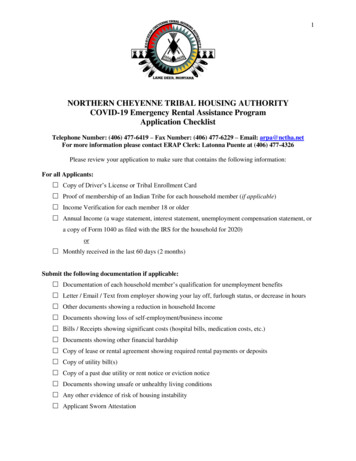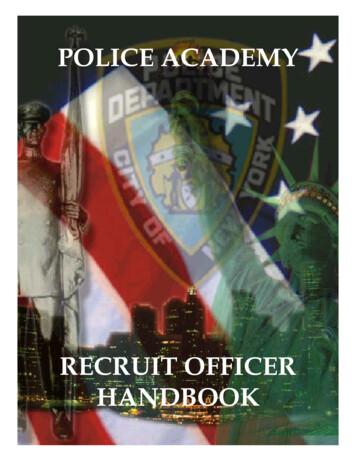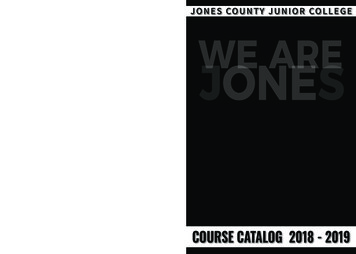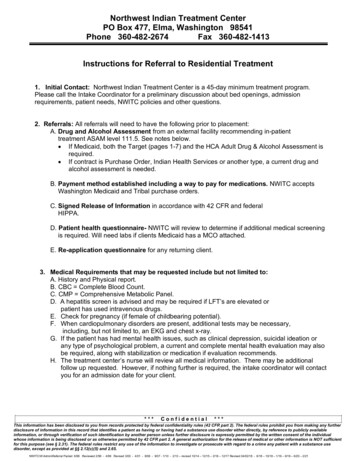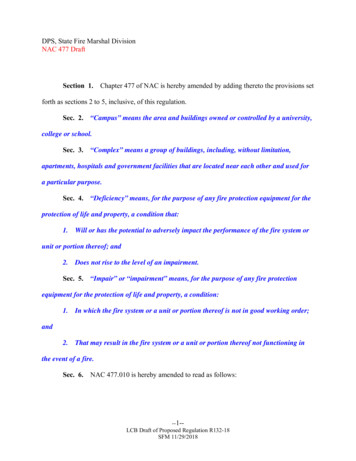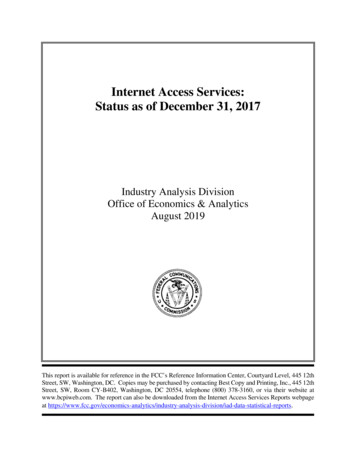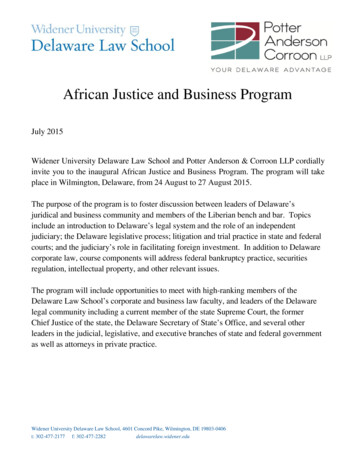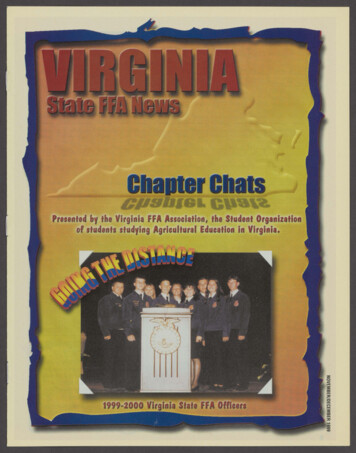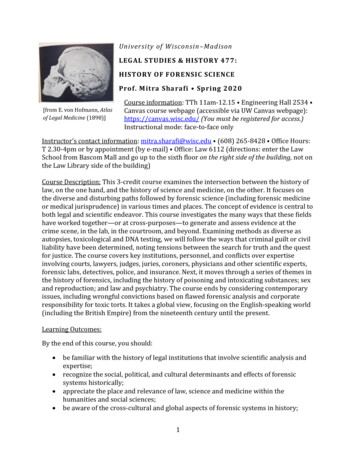
Transcription
University of Wisconsin –MadisonLEGAL STUDIES & HISTORY 477:HISTORY OF FORENSIC SCIENCEProf. Mitra Sharafi Spring 2020[from E. von Hofmann, Atlasof Legal Medicine (1898)]Course information: TTh 11am-12.15 Engineering Hall 2534 Canvas course webpage (accessible via UW Canvas webpage):https://canvas.wisc.edu/ (You must be registered for access.)Instructional mode: face-to-face onlyInstructor’s contact information: mitra.sharafi@wisc.edu (608) 265-8428 Office Hours:T 2.30-4pm or by appointment (by e-mail) Office: Law 6112 (directions: enter the LawSchool from Bascom Mall and go up to the sixth floor on the right side of the building, not onthe Law Library side of the building)Course Description: This 3-credit course examines the intersection between the history oflaw, on the one hand, and the history of science and medicine, on the other. It focuses onthe diverse and disturbing paths followed by forensic science (including forensic medicineor medical jurisprudence) in various times and places. The concept of evidence is central toboth legal and scientific endeavor. This course investigates the many ways that these fieldshave worked together—or at cross-purposes—to generate and assess evidence at thecrime scene, in the lab, in the courtroom, and beyond. Examining methods as diverse asautopsies, toxicological and DNA testing, we will follow the ways that criminal guilt or civilliability have been determined, noting tensions between the search for truth and the questfor justice. The course covers key institutions, personnel, and conflicts over expertiseinvolving courts, lawyers, judges, juries, coroners, physicians and other scientific experts,forensic labs, detectives, police, and insurance. Next, it moves through a series of themes inthe history of forensics, including the history of poisoning and intoxicating substances; sexand reproduction; and law and psychiatry. The course ends by considering contemporaryissues, including wrongful convictions based on flawed forensic analysis and corporateresponsibility for toxic torts. It takes a global view, focusing on the English-speaking world(including the British Empire) from the nineteenth century until the present.Learning Outcomes:By the end of this course, you should: be familiar with the history of legal institutions that involve scientific analysis andexpertise;recognize the social, political, and cultural determinants and effects of forensicsystems historically;appreciate the place and relevance of law, science and medicine within thehumanities and social sciences;be aware of the cross-cultural and global aspects of forensic systems in history;1
be able to identify the main argument of a scholarly reading;be skilled at writing essays that make an argument in relation to secondary-sourcereadings;be able to give an oral presentation based on independent research; andbe able to productively contribute to in-class discussion.If you are taking the graduate version of this course, you should additionally: be able to describe and critically assess historiographical developments in thesecondary literature; andbe able to advance an argument grounded in primary-source evidence in anextended research paper.How this course meets credit-hour policy standards: This course meets as a group for two75-minute sessions per week and carries the expectation that you will spend an average of3 hours outside of class for each class period. In other words, in addition to class time, youshould plan to allot an average of 6 hours per week for reading, writing, preparing fordiscussions, working on your research paper, and preparing the final reflection paper forthis class.Grades & Course Requirements: Reading responses and draft feedback (5%): You will be required to submit:a. three very short reading responses to class readings (max. 150 words) forany three classes marked with an asterix (*) below. You must sign up forthese classes on a first-come, first-served basis (any time until the work isdue) on our course website. Your reading response should consist of: (1) asuccinct response to the reading questions for the day (listed on the syllabus),and (2) a question of your own, prompted by the readings. You should type yourreading response directly into Canvas. (You can alternatively e-mail it to me ifthere are any issues with Canvas.) You should do no outside research for thereading responses. These reading responses will only be graded for completion,meaning that I will not give you a grade or comments, but will simply indicatethat you are getting credit for the reading response. If the standard is extremelylow or incomplete or if your reading response is up to 5 hours late (see below), Ireserve the right to give only partial credit (or no credit, in extreme cases). I willnot accept reading responses that are more than 5 hours late. Please note: I willaccept make-up reading responses (no need to sign up) on the last day of classonly (Class 27).b.one round of “track changes” feedback on classmates’ research paperdrafts: Once everyone has selected topics, you will be assigned to Group 1-4 forour research paper-based presentation sessions (Classes 21-24). During one ofthese sessions, you will give a short presentation based on your research paperdraft. During another session (assigned to you according to your presentationgroup), you will read your classmates’ first drafts and use “track changes” to add2
edits and comments. Your classmates will then use this feedback to revise theirpapers and submit the final versions of the paper.Your reading responses and draft paper feedback will be due electronically(submitted via our course website) Mondays by 12 noon for a Tuesday class orWednesdays by 12 noon for a Thursday class. There will be a penalty for lateness( work submitted after 12 noon but before 5pm on the day before class) and forreading responses that exceed the word limit. I will not accept submissions receivedafter 5pm on the day before class. I will also not notify you when your response orfeedback is late or missing. *It is your responsibility to know when your submissionsare due. * There will be one opportunity to make up for a missed reading responseor feedback round: Class 27. To boost your participation grade, you may submitfeedback on your classmates’ drafts on a session not assigned to you. Midterm exam (25%): Our closed-book midterm exam will take place during Class14 (Tuesday, March 10) in *Sewell Social Science Computer Lab, room 3218.*Please note that our exam will *not* be held in our normal classroom orbuilding. Research paper (20%): You will analyze one particular case study, technique, orschool of thought from the history of forensic science in this short research paper(2,500-3,000 words, plus bibliography). Please identify your topic via the sign-upscreen on our Canvas course page (max. one student per topic). I will provide a listof potential topics on the website, but you may also choose a topic that is not on thelist if you obtain my prior approval. I highly recommend that you come to see meduring office hours about your paper at least once.You may sign up via our Canvas course page any time during the two weeks after theopening of the list at 7pm on T, Feb.4, 2020. You must have signed up for a topic by7pm on T, Feb.18, 2020. A penalty will be applied to your overall paper grade ifyou sign up late.You must submit the first draft of your paper by 12 noon one week before your inclass presentation (presentations will take place during Classes 21-24). Forexample, if your presentation is scheduled for Thursday, April 16, then your firstdraft will be due by 12 noon on Thursday, April 9. Your short oral presentation willsummarize your paper. Your classmates assigned to your presentation class willread your first draft and provide you with written comments, which I will read first.The whole class will also have the chance to ask you questions on your workfollowing your presentation. Using your classmates’ comments, you will revise yourfirst draft and submit your final version of your paper by 12 noon one week afteryour in-class presentation. Continuing with the example above, this means that if3
you give your presentation on Thursday, April 16, your first draft will be due by 12noon on Tuesday, April 9 and your final version will be due by 12 noon on Tuesday,April 23. You must include with your final submission a cover note explainingchanges made in response to your classmates’ comments. Up to 48 hours after thefinal paper deadline, late papers will be accepted with a 5-point penalty (the paperwill be graded out of 100 points) for every 12 hours that the paper is late. Latepapers submitted more than 48 hours after the deadline will not be accepted. *It isyour responsibility to keep track of the scheduling deadlines associated with all stagesof your paper.* Final exam (30%): Our closed-book final exam will take place on Thursday, May 7,2020 at 2.45pm-4.45pm in *Sewell Social Science Computer Lab, room 3218.*Please note that our exam will *not* be held in our normal classroom orbuilding. Class attendance (10%): Coming to class is essential. This means arriving punctuallyand staying until the end of class. Lateness: Arriving more than 15 minutes late or leaving more than 15 minutes earlycounts as an absence from that day’s class. Arriving late ( up to 15 minutes after Ihave taken attendance) three or more times constitutes chronic lateness and willbe factored into your attendance grade. Absences: I will take attendance at the beginning of each day’s session. You maymiss up to two classes unexcused during the semester. There will be nodeductions for these two absences, and there is no need to let me know that you willbe missing these classes. Beyond these two absences, however, missing a class willcount as an unexcused absence. Exceptions include missing class for medical,military, or athletics-related reasons (all with documentation), or for religiousreasons (with prior notice). Missing class for a family vacation (beyond your twopermitted absences) will count as an unexcused absence. You will automaticallyfail the class if you have more than four unexcused absences (i.e., withoutdocumentation for an exception listed above and beyond the two allowableabsences) during the semester. If you have an ongoing medical condition that maycause periodic absences, please let me know (with documentation) as soon aspossible during the semester. In such cases, we can set up alternative arrangementspertaining to attendance policy. Class participation (10%): You are expected to contribute regularly to class discussions.If you are uncomfortable speaking in class, you should come to see me during office hoursin order to express your thoughts on course materials in an alternative setting.Participation is particularly important on the days when you have submitted a readingresponse. You should be aware that absences may have an adverse effect not only on your4
attendance but also on your participation grade, as you cannot participate if you are notpresent. Graduate version of this course: If you are taking this course as a graduate student, yourgrade will be based on the three reading responses described above (5%) and anextended research paper (5,000-6,000 words, plus bibliography) due toward the end ofthe semester (date to be agreed upon with instructor) (75%), along with attendance(10%) and participation (10%). You will not take the midterm or final exam, nor will yoube required to give a presentation or attend Classes 21-24 (Presentations of groups 1-4).You should prepare your research paper in consultation with instructor, and you shouldread broadly in the field of the history of forensic science so that you can situation yourtopic within it. A good place to start is with this article: Christopher Hamlin, “Forensiccultures in historical perspective: Technologies of witness, testimony, judgment (andjustice?),” Studies in History and Philosophy of Biological and Biomedical Sciences 44(2013), 4-15. Grading scale: A: 90% and above AB: 85-89% B: 80-84% BC: 75-79% C: 65-74% D: 55-64% F: below 55%See the grading rubric posted on our course website.Disabilities or other medical issues: If you have a disability, learning difficulty or other medical condition that you feelmay affect your work, attendance or participation in our course, please let me know(with documentation) as early as possible during the semester. Any such discussionswill remain confidential. The McBurney Disability Resource Center offers specialfacilities through which students may take exams (for instance, with time and a half), soit is important that you let me know of any special support you may require:http://www.mcburney.wisc.edu/ Where appropriate, we may also set up alternativearrangements pertaining to attendance.Diversity and inclusion: Diversity is a source of strength, creativity, and innovation in this course and at UWMadison. I value the contributions of each person and respect the profound ways youridentity, culture, background, experience, status, abilities, and opinion enrich theuniversity community. I also see the pursuit of excellence in teaching and diversity asinextricably linked goals. The University of Wisconsin-Madison fulfills its public missionby creating a welcoming and inclusive community for people from every background –5
people who as students, faculty, and staff serve Wisconsin and the world.https://diversity.wisc.edu/Format for written Work: Reading responses: You should type your responses directly into Canvas in the dropboxfor the relevant class number. You should submit annotated versions (using “trackchanges”) of your classmates’ research paper drafts to the relevant dropbox on Canvas. Research paper: Your research paper should be typed in 12-point font with 1-inchmargins, double-spaced, and submitted electronically via our Canvas course page. If indoubt about whether your submission has been properly submitted using Canvas,please also e-mail your paper to me. However, our Canvas dropboxes are my preferredmethod of submission.Course materials: All readings for the course are available electronically through our Canvas coursewebsite. Because laptops may not be used in class (see below), I recommend that youbring summary notes to class if you want to avoid printing out the readings for eachday’s class. Your summary notes should enable you to answer the reading questions forthe day’s readings (posted on the syllabus for each class). I also recommend that aftertaking notes on a reading, you fill in the following headings in one sentence each: 1.summary of the main argument, 2. most important contribution, 3. most seriouscriticism, 4. how this reading fits with our other course readings and themes. Usually,bringing a record of these four summary headings (along with the answers to thereading questions) should be enough to enable you to participate in our in-classdiscussion.Course content note: Please note that some of the course content is graphic and disturbing in nature,including material that relates to violence, blood, sexual assault, and abortion. If yoususpect that specific material is likely to be emotionally challenging for you, I’d behappy to discuss any concerns you may have before the subject comes up in class.Likewise, if you ever wish to discuss your personal reactions to course material withthe class or with me individually afterwards, I welcome such discussions as anappropriate part of our classwork.Technology: Laptop ban: For pedagogical reasons, I do not allow the use of laptops or otherelectronic devices (including phones) in class. In order to ensure a full and engagedlearning experience, the use of any type of electronic device in class is prohibited unlessrequired for properly documented medical reasons and/or arranged through theMcBurney Center. This includes the wearing of headphones during class. Any6
recordings made of our class (using the medical/McBurney exception) shall be forstudents’ own study purposes. Such recordings shall only be made with priorpermission from me and are not to be made available to anyone outside of our class. E-mail etiquette: Please e-mail me with any procedural or logistical questions after youhave consulted our syllabus and Canvas page and been unable to find the answer there.(If you notice that something is missing or incorrect on Canvas, I would appreciate an email.) In general, you will get better quality feedback and substantive discussion bycoming to office hours. All e-mails should include the appropriate form of greeting andbe signed with your name. I will not reply to messages that do not include these basiccourtesies. In this course (as in life), you should aim to be clear and polite in your emails, delete automatic signatures that are not appropriate, and reread your messagesbefore you send them.Academic Misconduct: The stakes: You have a lot to lose if found to have committed academic misconduct.Misconduct during your undergraduate years may be recorded and submitted to futurepotential employers and institutions for post-graduate study. If you plan to apply to lawschool or graduate school, you should realize that any academic misconduct couldprevent you from being accepted, or from pursuing your desired profession later on(e.g., practicing law). It is therefore critical that you familiarize yourself with UW’spolicies and procedures governing academic mic-integrity/ Plagiarism: Any intentional attempt to claim the work or efforts of another personwithout authorization or citation constitutes academic misconduct. This includescutting and pasting text from the web without quotation marks or proper citation, orparaphrasing from the web (or any other source) without crediting the original. I takesuch actions seriously, and regularly do anti-plagiarism checks on studentassignments. If I suspect that you have plagiarized, I may request an in-person meetingand may penalize you in grading your assignment. Failure to meet with me in person todiscuss these issues may result in an “incomplete” for the assignment and potentiallyfor the course. In addition, I may pursue disciplinary measures. Other forms of misconduct: Because I grade on a curve, cheating by your classmatesaffects your grade directly. If you believe that a classmate has committed academicmisconduct, report it to me.Course Reading Schedule: T, Jan.21, Class 1: Overview of the course (no readings) Th, Jan.23, Class 2: Introduction to the history of forensic science throughcurrent events round-up readings (from the final class of History of ForensicScience, spring 2019)7
Q: What forensic-related issues and themes emerge from the 2019 news stories here?Which ones pose the greatest challenges, to your mind, and why?o readings posted on course website T, Jan.28: Class 3: Jigsaw discussion #1—Forensic experts. Do the ONE set ofreadings below that will be assigned to you by group (groups A-D to be determinedbefore this class). Be prepared to explain this reading to classmates who have notdone the same reading. For further details, see handout (to be distributed andposted in advance):o Group A: Thomas T. Noguchi, Coroner (New York: Simon and Schuster, 1983),54-86 (Ch.3: Medical Examiner’s Case No. 81128. Marilyn Monroe)o Group B: Zakaria Erzinclioglu (AKA Dr. Zak), Maggots, Murder, and Men:Memoirs and Reflections of a Forensic Entomologist (New York: ThomasDunne Books, 2000), 22-48 (Ch.2: The Nature of Evidence)o Group C: Mary H. Manhein, The Bone Lady: life as a forensic anthropologist(New York: Penguin Books, 2000), 27-30 (Ch.3: Sis), 63-9 (Ch.12: Lost andMissing Children), 70-81 (Ch.13: Capitol, Ch.14: Indian Woman), 91-3 (Ch.18:Clouds and Horses), 125-37 (Ch.26: Civil War on the Bluff, Ch.27: For ThoseWho Wait)o Group D: Walter Borden, Wild Justice: Memoir of a Forensic Psychiatrist (N.Charleston: Independent, 2017), xi-xiii, 33-57 (Ch.5: Eve, Ch.6: Beth, Ch.7:Crystal) Th, Jan.30: no class today (recommended: use class time to investigate potential LPpaper topics—see posted list and links on Canvas website) T, Feb. 4, Class 4: *Police, detectives, & detectiono Ian Burney and Neil Pemberton, Murder and the Making of English CSI(Baltimore: Johns Hopkins U. Press, 2016), 153-83 (Ch.7: Interrogating the“House of Murder”)Q: How did the rise of Crime Scene Investigation change the approach to the detectionof crime in 20th-century England, and how did the infamous Christie case make thesechanges visible? T, Feb.4: Sign-up list for research paper topics opens at 7pm (course website):sign up for a topic (max. one person per topic) during the next two weeks; seeposted PDF for list of topics Th, Feb. 6, Class 5: *Death investigation 1. Q&A with Dr. Michael A. Stier,forensic pathologist and Assoc. Prof. of Pathology and Laboratory Medicine, UWSchool of Medicine and Public Healtho To watch in advance: Frontline documentary (53min.), Post Mortem: DeathInvestigation in America (PBS, mortem/8
Q: What aspects of death investigation in the US today are problematic, and why? T, Feb. 11, Class 6: *Courts & scientific experts Tal Golan, “The History of Scientific Expert Testimony in the English Courtroom,”Science in Context 12:1 (1999), 7-32 Rebecca Trager, “Forensics in Crisis,” Chemistry World (15 June 2018), PDFversion: 1-9Q: How has the role of forensic experts changed in the English-speaking world sincethe eighteenth century, and what key issues have arisen? Th, Feb.13, Class 7: Jigsaw discussion #2—Detective fiction worldwideDo the ONE set of readings below that will be assigned to you by group (groups E-Hto be determined before this class). Be prepared to explain this reading toclassmates who have not done this reading. For further details, see handout (to bedistributed and posted in advance):o Group E: Arthur Conan Doyle, “The ‘Gloria Scott,’” 1-9 and “The Adventure ofthe Speckled Band,” 1-12 from The Adventures of Sherlock Holmes (fromProject Gutenberg)o Group F: N. R. Gupta, “Blood-faced Dragon” in Kiriti Omnibus, vol.2 (Kolkata,1972); translation from Bengali by Anwesha Maity (2018), 1-34o Group G: Agatha Christie, “Sanctuary” in Miss Marple: The Complete ShortStories (New York: Dodd, Mead and Company, 1985), 324-46o Group H: Shizuko Natsuki, “Cry from the Cliff” in Ellery Queen’s JapaneseGolden Dozen: The Detective Story World in Japan (Rutland, VT and Tokyo,Japan: Charles E. Tuttle Co., 1978), 123-45 T, Feb.18, Class 8: *Insuranceo Sharon Ann Murphy, Investing in Life: Insurance in Antebellum America(Baltimore: Johns Hopkins U. Press, 2010), 77-96 (Ch.3. Lying, Cheating, andStealing versus The Court of Public Opinion: Preventing Moral Hazard andInsurance Fraud), 232-7 (excerpt from Ch.8. Acting ‘in defiance of Providence’?The Public Perception of Life Insurance), plus notesQ: Why were murder and suicide key challenges for the early American life insuranceindustry, and how did the industry respond? T, Feb.18: Sign-up list for research paper topics closes at 7pm today (Canvas) Th, Feb.20, Class 9: *Signs of the body 1o Mitra Sharafi, “The Imperial Serologist and Punitive Self-Harm: Bloodstains andLegal Pluralism in British India” in Ian Burney and Christopher Hamlin, eds.,Global Forensic Cultures: Making Fact and Justice in the Modern Era (Baltimore:Johns Hopkins University Press, 2019), 60-85Q: Why was the precipitin test of special value to colonial authorities in British India?What does its importance, along with the creation of the Imperial Serologist, reveal9
about the interaction between private disputing and the criminal justice system in acolonial setting? T, Feb. 25, Class 10: *Signs of the body 2o Adam Cohen, Imbeciles: The Supreme Court, American Eugenics, and theSterilization of Carrie Buck (New York: Penguin Books, 2017), 1-14(Introduction)o Podcast to listen to in advance (19min.): “Sterilized,” Life of the Law (featureepisode 79): http://www.lifeofthelaw.org/2016/03/sterilized/ or read thetranscript: nscript/Q: How and why was Carrie Buck sterilized without her consent, and how did her storyresemble those of thousands of other Americans in the mid-20th century? Th, Feb. 27, Class 11: *Poisoningo David Arnold, Toxic Histories: Poison and Pollution in Modern India (Cambridge:Cambridge U. Press, 2016), 1-7 (from Introduction) and 17-40 (Ch.1: The sociallife of poisons)Q: What cultural and religious narratives about poison have existed in the history ofIndia, and how does poison fit into the history of gender, poverty, and medicine inIndia? T, March 3, Class 12: Jigsaw discussion #3—Intoxicating substances: Do theONE set of readings below that will be assigned to you by group (groups I-L to bedetermined before this class). Be prepared to explain this reading to classmates whohave not done the same reading. For further details, see handout (to be distributedand posted in advance):o Group I: Deborah Blum, The Poisoner’s Handbook: Murder and the birth offorensic medicine in Jazz Age New York (New York: Penguin, 2011), 38-41 and46-9 (from Ch.2: Wood Alcohol 1918-19), 152-64 (from Ch.7: Methyl Alcohol1927), and 196-207 (from Ch.9: Ethyl Alcohol, 1930-1932)o Group J: Barron H. Lerner, One for the Road: Drunk Driving since 1900(Baltimore: Johns Hopkins Press, 2011), 1-3 (from Introduction), 38-63 (Ch.2:Science and Government Enter the Fray)o Group K: (1) Catherine Carstairs, Jailed for Possession: Illegal Drug Use,Regulation, and Power in Canada, 1920-1961 (Toronto: University of TorontoPress, 2006), 16-34 (Ch.1: The Drug Panic of the 1920s and the Drive forChinese Exclusion); (2) Shreeya Sinha with Zach Lieberman and Leslye Davis,“A Visual Journey through Addiction,” New York Times (18 Dec. 2018), PDFversion: 1-6 [online version recommended for full s/addiction-heroinopioids.html]o Group L: (1) Emily Dufton: Grass Roots: The Rise and Fall and Rise ofMarijuana in America (New York: Basic Books, 2017), 1-10 (Introduction: AHigher Calling) and 207-24 (Ch.12: The Florence Nightingale of Medical10
Marijuana); (2) Elie Dolgin, “What legal weed in Canada means for science,”Nature 562 (2018), 327-30; and (3) Eric Westervelt, “The Pot Breathalyzer ishere. Maybe,” NPR website (4 August 2018), PDF version: 1-6 Th, March 5, Class 13: *Death investigation 2 Jeffrey M. Jentzen, Death Investigation in America: Coroners, MedicalExaminers, and the Pursuit of Medical Certainty (Cambridge, MA: HarvardUniversity Press, 2009), 1-30 (Introduction, Ch.1: Good and Lawful Men)Q: How did the English coroner’s system operate in America, and what criticismsand reform attempts were made? T, March 10, Class 14: Midterm exam in Sewell Social Science computer lab,room 3218. Please note that our exam will *not* be held in our usual classroomor building. Th, March 12, Class 15: *Sex & reproduction 1o Thomas Pegelow Kaplan, “ ‘In the Interest of the Volk ’: Nazi-German PaternitySuits and Racial Recategorization in the Munich Superior Courts, 1938-1945,”Law and History Review 29 (2011), 523-48Q: Why did certain people living in Nazi Germany claim that the men assumed to betheir biological fathers were actually not their fathers, and how did they try toprove it? Sat., March 14-Sunday, March 22: spring break T, March 24, Class 16: *Sex & reproduction 2o Barbara Baird, “I had one too ” An Oral History of Abortion in South Australiabefore 1970 (Bedford Park, Australia: Women’s Studies Unit, FlindersUniversity of South Australia, 1990), 35-7 (The Interviewees), 39-45 (Whywomen wanted abortions), 49-57 (How women procured abortions), 77-90(Backyard abortions, Self-induced abortion before 1970)Q: What do the oral history interviews in Baird’s study reveal about abortion inSouth Australia before its decriminalization in 1970?Th, March 26, Class 17: Jigsaw discussion #4—Forensic science and massatrocitiesDo the ONE set of readings below that will be assigned to you by group (groups M-Pto be determined before this class). Be prepared to explain this reading toclassmates who have not done the same reading. For further details, see handout (tobe distributed and posted in advance):o Group M: Victoria Sanford, Buried Secrets: Truth and Human Rights inGuatemala (New York: Palgrave Macmillan, 2003), excerpts including 30-48(Ch.1: “The Bones Don’t Lie”)11
o Group N: Adam Rosenblatt, Digging for the Disappeared: Forensic Scienceafter Atrocity (Palo Alto: Stanford University Press, 2015), 125-52 (Ch.3:Forensics of the Sacred)o Group O: Eden Medina, “Forensic Identification in the Aftermath of HumanRights Crimes in Chile: A Decentered Computer History,” Technology andCulture 59 (2018):4, 100-129o Group P: (1) Physicians for Human Rights, “Darfur: Assault on Survival. A Callfor Security, Justice, and Restitution” (2006), excerpts including 15-17 (IV.Investigation and Techniques); (2) John Hagan, “Voices of the DarfurGenocide,” Contexts 10 (2011):3, 22-28, PDF version: 1-14 T, March 31, Class 18: *Law & psychiatry 1o Peter McCandless, “Liberty and Lunacy: The Victorians and WrongfulConfinement,” Journal of Social History 11:3 (1978), 366-86Q: Why did so many people fear being confined to a mental institution in VictorianEngland, and what factors contributed to wrongful commitment? Th, April 2, Class 19: *Law & psychiatry 2o Elaine S. Abelson, “The Invention of Kleptomania,” Signs 15:1 (1989), 123-42Q: How did shoplifting come to be a “fashionable” form of crime in the Anglo-Americanworld in the late 19th century (with class and gendered associations) and how was thepsychiatric diagnosis of kleptomania justified both scientifically and legally?Th, April 2 (by 12 noon): start of rolling submission deadline for first draft of researchpaper. Your first draft i
University of Wisconsin-Madison LEGAL STUDIES & HISTORY 477: HISTORY OF FORENSIC SCIENCE Prof. Mitra Sharafi Spring 2020 Course information: TTh 11am-12.15 Engineering Hall 2534 Canvas course webpage (accessible via UW Canvas webpage): https://canvas.wisc.edu/ (You must be registered for access.) Instructional mode: face-to-face only
